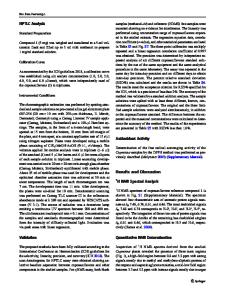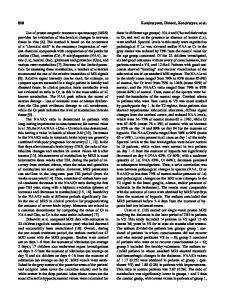Thermal Stressed State of a Magnetic Layer Under Ferromagnetic Resonance
- PDF / 934,277 Bytes
- 10 Pages / 594 x 792 pts Page_size
- 40 Downloads / 323 Views
THERMAL STRESSED STATE OF A MAGNETIC LAYER UNDER FERROMAGNETIC RESONANCE О. R. Hachkevych,1, 2, 3 М. T. Solodyak,1 R. F. Terlets’kyi,1 and М. H. Hachkevych1
UDC 539.3: 538.54
We propose representations for the magnetic field strength and establish expressions for the magnetization, magnetic-field induction, and energy and force factors of the action of magnetic fields under the conditions of ferromagnetic resonance. We determine and analyze the distributions of temperature, displacements, and stresses (the components of both symmetric and asymmetric tensors) over the thickness coordinate and, in particular, in the vicinity of resonance frequencies. Keywords: ferritic layer, electromagnetic field, ferromagnetic resonance, thermal stressed state, resonance frequencies.
The expressions for the components of magnetization, magnetic-field induction, and energy and force factors in the magnetic material of a layer via the components of the magnetic-field strength were obtained earlier in [1].
In what follows, we propose explicit representations for the components of the magnetic field with regard for the phenomenon of ferromagnetic resonance (FR). These representations can be used for the determination of the magnetic characteristics of the field and the energy and force factors [2–4]. Relations of Electrodynamics
Consider the case where the vector of magnetic field H1 harmonically rotates in the plane xOy [1] perpendicular to a constant field H0 , i.e., its components, according to the notation proposed in [1], have the form [2, 4]
1 , 2
hx =
hy =
1 , 2i
hz = 0 ,
(1)
or H x = H 1 cos ωt , H y = H 1 sin ωt , and H z = H 0 . Hence, the components of the magnetic-field strength are absent in the second approximation ( h2 j ≡ 0 , h2 j ≡ 0 , j ≡ (x, y, z) ). In this case, the components of magnet-
ization and magnetic-field induction {see relations (39)–(45) in [1]} take the form 1 2 3
Pidstryhach Institute for Applied Problems in Mechanics and Mathematics, Ukrainian National Academy of Sciences, Lviv, Ukraine. Corresponding author; e-mail: [email protected]. Opole Polytechnic University, Opole, Poland.
Translated from Fizyko-Khimichna Mekhanika Materialiv, Vol. 51, No. 2, pp. 91–97, March–April, 2015. Original article submitted June 25, 2013. 244
1068-820X/15/5102–0244
© 2015
Springer Science+Business Media New York
THERMAL STRESSED STATE OF A MAGNETIC LAYER UNDER FERROMAGNETIC RESONANCE
mx = −
ωM , 2Δ 0 bx =
my =
iω M = − im x , 2Δ 0
mz = 0 ,
(1 − iα s )ω − (ω H + ω M ) , 2Δ 0
(1 − iα s )ω − (ω H + ω M ) by = = − ibx , 2iΔ 0 bz = 0 ,
m2z
245
(2)
ωHωM , 2d 0 (ω)
= −
where
Δ 0 ≡ (1 − iα s )ω − ω H
and
d 0 (ω) ≡ Δ 0 ⋅ Δ! 0 = (1 + α 2s )ω 2 − 2ω H ω + ω 2H .
(3)
Note that all other components are equal to zero and the Walker equation [1] is identically satisfied. We write now the initial expressions for the amplitude of harmonics (1) and (2) of the magnetic-field strength, magnetic-field induction, and magnetization
AH =
hx h!x + hy h!y = H 1 ,
AM = H 1 ( m x m! x + m y m! y ) = AB = µ
Data Loading...











